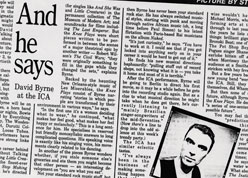ORIGINAL
PRESS CLIPPINGS

A LIGHTHANDED MIX OF ELEGANCE AND EARTHINESS
Sometimes Byrne's lyrics, read in impressively Byrne-like fashion by Matthew Buckingham, take unfortunate turns, as in "We loved one another so much that one could smell the other one and cry." Sometimes they deliberately teeter between contradictions in order to heighten tension, especially when Byrne envisions the future: "In the future, everyone will be fat and have to diet/In the future nobody will have enough to eat." Sometimes they seem complementary, in the skewed, deadpan way Byrne favors: "Every house will be like a little fortress/Every house will be a total entertainment center."
Byrne's use of traditional Dixieland betokens his growing interest in homespun Americana, a pursuit he's said to follow in his upcoming film, "True Stories." The important thing here is that his spiky, metronomic distress signals behave synergistically with the Japanese conventions. Every now and then each yanks the other into a startling, unpredictable, improbably affecting orbit. The means of "the Knee Plays" are physically simple, but their associative rewards are frequent. Part of the fun of watching them is that we know going in that we're not scaling Parnassus with Wilson tonight, we're sitting relaxed with something small-scale, disarmed at ripple after ripple as the disparate, yet harmonious, elements keep connecting.
Since Wilson persists in calling his theater pieces operas, critics have persisted in labeling them Wagnerian, full of grandiosity, but also given to bloat. These much more intimate pieces glint and dance. Despite their deconstructivist ethic, "the Knee Plays" are as close as Wilson probably ever will get to Mendelssohn in spirit. They're Wilson's scherzos. His grand culture- bridging design, linking Civil War America to Japan on the verge of Westernization, is apparent enough in the synopsis built into "the Knee Plays," and somehow seems benign in an olympian, philosophical way when the dancers, addressing their themes, break out of Hanayagi's Japanese-derived choreography and employ jerky, mechanistic New Wave moves to bring Wilson's para-national chamber piece full circle.